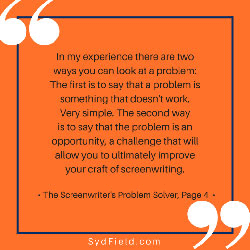Screenwriter, Heal Thyself
Screenwriters are often people with problems. Midway through the second act, we will write ourselves into a corner. Now the ending doesn’t work. Every character starts to sound exactly the same. Is this opening scene the right place to start my story? As Syd Field points out in The Screenwriter’s Problem Solver, “we often find ourselves lost in the maze of our own creation.”
Our script’s problems might be so numerous that we’re overwhelmed by them – what I like to refer to as ‘total body failure’ – or they may refuse to show themselves to us at all. We’re certain they’re out there, but they’re ghosting us. All we have is a vague and uneasy sensation that something is seriously wrong with our current work.
We suffer most acutely when we don’t have the first inkling of where to begin fixing these issues. If fortune smiles upon us, our problems are painful and obvious, like a dangling severed limb. The stealthy ones are more concerning, like a low-grade fever infecting our pages.
If you’re still parsing out a first draft, each completed scene can feel like you’re multiplying the maladies. We might suspect that we’ll require a strong antidote to contain the epidemic, but we will continue to press forward in denial. The screenwriter’s prayer is for these terminal conditions to somehow magically resolve themselves by the time we type FADE OUT.
But in screenwriting, nothing fixes itself. So, where to begin?
Enter The Screenwriter’s Problem Solver. It’s an excellent bookshelf companion for Screenplay: The Foundations of Screenwriting and The Screenwriter’s Workbook. And here’s the genius of this particular book: it functions as a first aid kit for your writing process.
What, exactly, constitutes a problem when it comes to screenwriting? Syd tells us that a problem is “anything that doesn’t work.” Maybe it’s a line of dialogue, or an entire scene. It could be a sequence or an entire act. It’s entirely possible the whole damn thing doesn’t work. Yet.
Within The Screenwriter’s Problem Solver you’ll find a curative and restorative method designed to resuscitate any problem-plagued writer. Some writers may be better at this process than others, but no one acquires immunity by elevated status or through years of experience.
In fact, you may be lousy at figuring out your own diagnoses right now. You’ll improve with time and practice. Eventually, you’ll develop a preventative regime that helps you to avoid most of your biggest mistakes before they happen.
I came to believe in the power of the Screenwriter’s Problem Solver as I was trying to sidestep falling into what Syd dubbed “The Pit” – that place of utter despair where you believe you’re a hack with a screenplay that’s better suited for kindling fires than impressing readers. When you’re in The Pit you’re all alone with your pity party, but when you reach The Wall you’ve found a problem. And, hoo boy, had I hit The Wall. Headfirst, with a possible concussion.
I started sifting through The Screenwriter’s Problem Solver, knowing I could find solace and solutions. You don’t so much read it cover to cover as flip to the relevant sections, trying to puzzle out what’s happened to your once brilliant idea for a screenplay.
There it was: Chapter 6: Dazed, Lost and Confused.
Syd had seen this sort of problem before.
Also, Chapter 7: The Nature of Dull.
I had that problem, too.
Syd Field understood my situation. “Confusion is the first step toward clarity,” he said.
When you reach The Wall, your main problem is to figure out a way around it. Or over it. Or under it. You can even smash right through it. Getting past this obstacle, however, requires you to outsmart yourself.
Admitting that you have a problem (or several) is the first step to finding it. And finding problems fuels your creativity. Like a wise Zen teacher, Syd’s teachings reminded me that I had created these problems, all by myself, so I had the power within to solve them. The laws of the screenplay universe tell us that every problem can be solved, and every failed solution is one step closer to a successful one.
According to Syd, three things are responsible for all of your troubles: Plot, Character, or Structure.
Now, wait an everlasting second, you may be thinking. Isn’t that everything?
No, not even close. A million and five things can go wrong with your writing, but each one traces back to one of these three categories.
In his book, Syd gives a breakdown of familiar screenwriting symptoms, then he helps you to connect each symptom to one of the three underlying causes. So take heart. Your dialogue may be terrible, for example, but this is merely a symptom of a larger issue with your characters. If your story isn’t working, examine the delicate balance between structure and plot.
Also, there’s immense power behind Syd’s suggested stream-of-consciousness writing activities. They’re simple, elegant and spot-on, deftly tucked away inside the chapters and appearing at exactly the right moment to be of assistance.
If your screenplay is in rough shape you may need to perform triage, tackling the most severe problems first. Stabilize these larger problems, then move on to addressing the minor issues. No sense in whitening the patient’s smile if he’s suffering from a broken jaw and ten missing teeth.
Syd doesn’t promise an easy road to recovery. Anyone who’s gone through physical therapy will tell you how exhausting it can be. It’s tough to show up every day and face The Wall. But if you do, day by day it will diminish, one brick at a time. You and your screenplay will emerge stronger on the other side. You’ll be ready to face the new problems with your next project. And…the next time you start to notice those familiar symptoms, you’ll also possess the remedy for exactly what to do in Syd Field’s The Screenwriter’s Problem Solver.


Comments are closed.